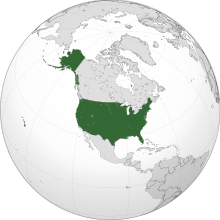
Back تاريخ اليهود في الولايات المتحدة Arabic История на евреите в САЩ Bulgarian Dějiny Židů ve Spojených státech amerických Czech Geschichte der Juden in den Vereinigten Staaten German Historia de los judíos en Estados Unidos Spanish Histoire des Juifs aux États-Unis French ԱՄՆ-ի հրեաների պատմություն Armenian Yahudi-Amerika Serikat ID Storia degli ebrei negli Stati Uniti d'America Italian په متحده ایالتونو کې د یهودو تاریخچه Pashto/Pushto

| This article is part of a series on the |
| History of the United States |
|---|
 |
There have been Jewish communities in the United States since colonial times, with individuals living in various cities before the American Revolution. Early Jewish communities were primarily composed of Sephardi immigrants from Brazil, Amsterdam, or England.
Private and civically unrecognized local, regional, and sometimes international networks were noted in these groups in order to facilitate marriage and business ties. This small and private colonial community largely existed as undeclared and non-practicing Jews, a great number deciding to intermarry with non-Jews. Later on, the vastly more numerous Ashkenazi Jews that came to populate New York, New Jersey, and elsewhere in what became the United States of America altered these demographics.
Until the 1830s, the Jewish community of Charleston, South Carolina, was the largest in North America. In the late 1800s and the beginning of the 1900s, many Jewish immigrants arrived from Europe. For example, many German Jews arrived in the middle of the 19th century, established clothing stores in towns across the country, formed Reform synagogues, and were active in banking in New York. Immigration of Eastern Yiddish-speaking Ashkenazi Jews, in 1880–1914, brought a new wave of Jewish immigration to New York City, including many who became active in socialism and labor movements, as well as Orthodox and Conservative Jews.
Refugees arrived from diaspora communities in Europe after the Holocaust and, after 1970, from the Soviet Union. Politically, American Jews have been especially active as part of the liberal New Deal coalition of the Democratic Party since the 1930s, although recently there is a conservative Republican element among the Orthodox. They have displayed high education levels and high rates of upward social mobility compared to several other ethnic and religious groups inside America. The Jewish communities in small towns have declined, with the population becoming increasingly concentrated in large metropolitan areas. Antisemitism in the U.S. has endured into the 21st century, although numerous cultural changes have taken place such as the election of many Jews into governmental positions at the local, state, and national levels.
In the 1940s, Jews comprised 3.7% of the national population. As of 2019[update], at about 7.1 million,[1] the population is 2% of the national total—and shrinking as a result of low birth rates and Jewish assimilation.[2] The largest Jewish population centers are the metropolitan areas of New York (2.1 million), Los Angeles (617,000), Miami (527,750), Washington, D.C. (297,290), Chicago (294,280) and Philadelphia (292,450).[3]
- ^ An estimated figure, as the following sources claim the number to be either slightly higher or lower:
- Sheskin, Ira M.; Dashefsky, Arnold (2018). "United States Jewish Population, 2018". In Sheskin, Ira M.; Dashefsky, Arnold (eds.). The American Jewish Year Book, 2018, Volume 118. Dordrecht: Springer. pp. 251–348.
The 2018 American Jewish Year Book (AJYB) estimate for the US Jewish population is about 6.925 million and is based, as in previous years, on the aggregation of over 900 local estimates.
{{cite book}}: External link in|chapter= - Tighe, Elizabeth; de Kramer, Raquel Magidin; Parmer, Daniel; Nussbaum, Daniel; Kallista, Daniel; Seabrum, Xajavion; Saxe, Leonard (2009). American Jewish Population Estimates 2019: Summary and Highlights (PDF) (Report). Steinhardt Social Research Institute, Brandeis University. p. 1. Retrieved 6 November 2019.
A total of 7.5 million people in the US are Jewish.
- Sheskin, Ira M.; Dashefsky, Arnold (2018). "United States Jewish Population, 2018". In Sheskin, Ira M.; Dashefsky, Arnold (eds.). The American Jewish Year Book, 2018, Volume 118. Dordrecht: Springer. pp. 251–348.
- ^ "The Vanishing American Jew". The New York Times.
- ^ Sheskin, Ira M.; Dashefsky, Arnold (2018). "United States Jewish Population, 2018". In Sheskin, Ira M.; Dashefsky, Arnold (eds.). The American Jewish Year Book, 2018, Volume 118. Dordrecht: Springer. pp. 251–348.
The 2018 American Jewish Year Book (AJYB) estimate for the US Jewish population is about 6.925 million and is based, as in previous years, on the aggregation of over 900 local estimates.
{{cite book}}: External link in|chapter=
© MMXXIII Rich X Search. We shall prevail. All rights reserved. Rich X Search